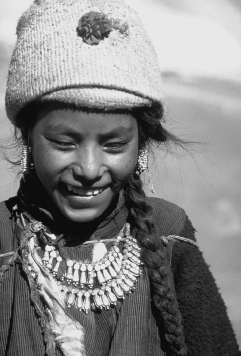|
|
1.2 Climate
Zanskar is a high altitude semi-desert lying on the Northern flank of the Great Himalayan Range. This mountain range acts as a climatic barrier protecting Ladakh and Zanskar from most of the monsoon, resulting in a pleasantly warm and dry climate in the summer. Precipitations during this season are thus scarce, although it seems that the last decades have seen an increase in pluviometry. We have indeed noticed several water driven mills, that were built, during ancient periods of drought at a great distance from the villages, but are now abandoned because running water is now available nearer to the houses. The Zanskari houses, which are otherwise especially well built, are not adapted to the recently increasing rainfalls as their roofs pretty fast start to leak, which catches their surprised inhabitants unprepared. Most of the precipitations occur as snowfalls during the harsh and extremely long lasting winter period. These winter snow falls are of vital importance since they feed the glaciers which will melt in the summer and provide most of the irrigation water.
1.3 Population
The number of people living in Zanskar is very small, the last census of the population (1971) was of 6886 souls. Tibetan Buddhism is the religion that largely prevails among Zanskari people although slightly tinted with relicts of animistic and shamanistic rituals. A small minority of Muslims (Shiites) also lives in Zanskar. The population is scattered in small villages, the largest being Padum the capital with nearly 700 inhabitants. Most of the villages are distributed along the valley of the Zanskar river and its two main tributaries. Given the isolation of this region, the inhabitants are condemned to rely essentially upon themselves and until recently lived in almost complete autarky.
|
 |
|
Trade with the outside was however always necessary to acquire goods like tools, jewels or religious artefacts. The Zanskaris live from cattle-rearing and from the farming of land that they almost always own. Cultivable land is however scarce and restricted to alluvial fans and terraces (cultivated fields are rarely found at an altitude exceeding 4000 meters in Zanskar). The Zanskaris thus had to do their best to successfully develop a system of intensive arable agriculture and complex irrigation that produces enough food and avoids fallows. The scarcity of cultivable land also implies that the population has to remain stable. A rather efficient birth control system in Zanskar was achieved by the common practice of polyandrous marriage (several brothers are married to the same wife) and the widespread adoption of celibate religious life. A high (natural) infantile mortality rate did also certainly contribute to maintain a stable population.
|
|
|
|
| Fig 1.4: Young Zanskari Girl on her way to see the Dalai Lama (©Y. Caloz, 1987) |
|
|
|
|
previous page "Geography" |
next page "Livestock" |
 |
©Pierre Dèzes
|